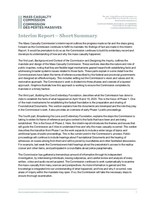TRURO, NS and HALIFAX, NS, May 2, 2022 /CNW/ - Today, the Mass Casualty Commission ("the Commission") is sharing its interim report. The interim report is a required step in the mandate and marks a significant checkpoint in the Commission's work. The report does not include recommendations or findings to date, as that work is still underway.
The interim report shares how the Commission is doing its work on behalf of Canadians to meet the requirements of the mandate outlined in the Orders in Council including the work to date, and what to expect as it fulfills its mandate. This includes the important questions that will be examined in relation to key topics, including critical incident response, firearms, police paraphernalia, intimate partner violence, rural communities, and post-event support.
The work of the Commission is ongoing, and the focus remains to better understand what happened, how and why it happened, and identify findings and recommendations to help make communities safer in future. Findings and recommendations will be included in the Commission's final report.
The Commission's work is organized into three phases. Phase 1 is ongoing and focuses on the facts of what happened. The Commission's second phase of public proceedings will broaden the focus of its work to explore how and why the mass casualty happened, considering the causes, contexts and circumstances that may have contributed. Phase 1 and 2 will run concurrently, and work will continue through the summer. Phase 2 is a bridge to the Commission's forward-focused Phase 3 work of identifying and developing meaningful recommendations for the future.
Proceedings are expected to take place until September 2022. Throughout proceedings the Commission will continue hear from people in a variety of ways including witness testimony, submissions, roundtables, and small group sessions to hear individuals' experiences directly.
"The interim report is an opportunity to share the Commission's approach and next steps. The work to answer what happened leading up to, during, and after the mass casualty in Nova Scotia continues as we turn to addressing the questions of 'how and why' that will inform the work of Phase 2," said Emily Hill, Senior Commission Counsel "We are committed to doing this work in a comprehensive and transparent manner."
"We are focused on answering the questions Nova Scotians and Canadians have, while keeping in mind that the material that we are discussing is difficult and continues to affect people across Nova Scotia, Canada, and beyond," Hill added.
As the Commission moves closer to developing recommendations for its final report, there will be ongoing opportunities for input from those most affected, experts, organizations and institutions and interested members of the public.
Regular updates are posted on the Commission's website, including the calendar of proceedings.
- Public proceedings began in February with hearings focused on the Commission's Phase 1 work to understand what happened on April 18 and 19, 2020. To date, the Commission has:
- Shared 14 of more than 30 Foundational Documents.
- Shared eight of its more than 20 Commissioned Reports.
- Posted to its website more than 1,000 source material documents, including police notes, 911 call transcripts, summaries of medical examiner reports and videos like security camera footage.
- Carried out over 200 investigative interviews, with more scheduled.
- Issued more than 70 subpoenas.
Interim report
Mandate
Orders in Council
Wellness supports
Foundational Documents
What are Commissioned Reports
Research and Commissioned Reports
Proceedings Calendar
About the Mass Casualty Commission: The Commission into the April 2020 Nova Scotia Mass Casualty (the "Mass Casualty Commission") is an independent public inquiry created to examine the April 18–19, 2020 mass casualty in Nova Scotia and to provide meaningful recommendations to help protect Canadians in the future. For more information, see https://MassCasualtyCommission.ca/.
SOURCE Mass Casualty Commission

Media Contact: [email protected]

Share this article